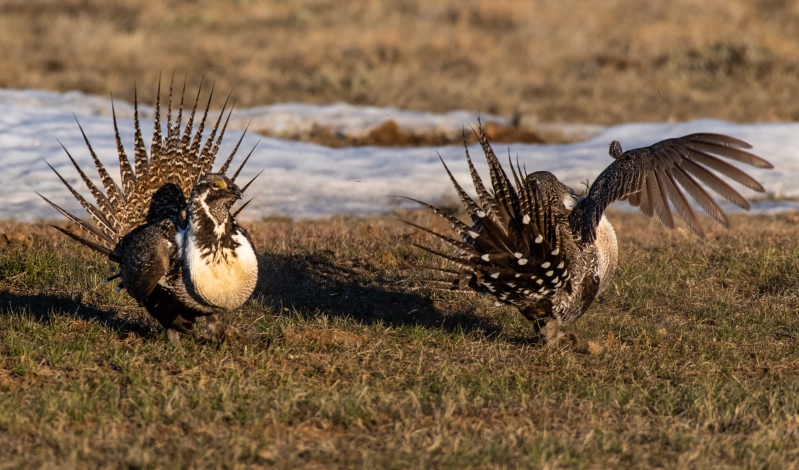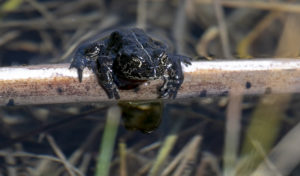
A federal compromise with industry and conservationists aims to preserve a disappearing species and ecosystem.
Could a chubby, chicken-like bird really be “the most powerful individual in the American West?”
It certainly seems so. That bird is the Greater Sage-Grouse, and its population is plummeting across the Western United States. As a result of potential endangered species protection, this little bird is throwing many big business projects into doubt.
Due to agricultural, infrastructure, and energy development, as well as invasive plants and wildfires, the sage grouse has lost nearly half of its historic habitat on which it depends for food, shelter, and survival. Listing the bird under the Endangered Species Act (ESA) would protect the big, open landscapes that the grouse needs to survive, but it would also cripple the western oil and gas, recreation, and ranching industries that rely on development in sagebrush country.
Forced to choose between the sage grouse’s survival and business activity, the U.S. Department of the Interior orchestrated a grand compromise in 2015 that brought together state and federal governments, private landowners, industries, and conservation organizations to protect the bird’s habitat without the department ever needing to make an ESA listing. Since then, policy reversals across the Obama, Trump, and Biden Administrations have tested the compromise’s ability to balance industry and conservation.
The sage grouse saga is a case study in modern regulatory compromise. In today’s polarized political environment, it can be tempting to see any policy that achieves consensus as a success. But, as Cary Coglianese of the University of Pennsylvania Carey School of Law has observed, “it would be a serious mistake to establish deal-making as the primary goal of domestic environmental policymaking.” Instead, the sage grouse compromise might be said to succeed only by accomplishing its established goal: “to protect, restore, and enhance important sage grouse habitat to preclude the need to list the species.”
The sage grouse compromise was developed because a 2011 court order, which required an ESA listing decision by September 2015, set conservationists and industry on a collision course.
Conservationists advocated a listing under the ESA, worried that the sage grouse and its green-gray habitat were disappearing. The grouse is an “umbrella species,” meaning that the bird’s well-being reflects the state of the entire sagebrush ecosystem, which includes 350 other species, such as pronghorn antelope, mule deer, and golden eagles. According to conservationists, the guaranteed protections of an ESA listing would save the sage grouse as well as the other inhabitants of the sagebrush landscape.
But western industries and their political supporters have cautioned that a listing would impose strict land use restrictions on the grouse’s 165-million acre habitat. The ESA prohibits “taking” a listed species, which includes not only killing or harming the animal, but also destroying critical habitat area. In the case of the sage grouse, the opponents of listing have argued that these provisions would cause a sharp decline in economic activity and with it a decline in employment and state and local revenue. In Wyoming, for example, it has been estimated that a listing could cost between $1.5 billion and $5.4 billion total because nearly 17 percent of the state’s GDP comes from energy development. Sage grouse habitat covers almost 70 percent of Wyoming.
Although a listing seemed in 2011 to be “almost a foregone conclusion,” the Interior Department spent four years brokering a deal that would save the bird through means other than an ESA listing.
The final compromise—heralded as the “largest land conservation effort in U.S. history”—brought together federal agencies, state governments, industries, private landowners, and conservation organizations to establish protections on 90 percent of sage grouse habitat. The habitat protections—which included requirements that developers avoid, minimize, or pay compensation for their impacts on grouse habitat to a new wildfire management strategy—were so robust that the agency decided not to list the sage grouse.
Nearly six years later, biologists say it is still too early to assess the compromise’s impact on the sage grouse’s health. Grouse populations have decreased significantly since 2016, but the rate of population decline may be slowing. Populations regularly fluctuated by 30 to 40 percent even before the agreement.
Absent clear data about the plan’s direct impact, it is worth considering whether the compromise is fulfilling its promise to balance development activity and sage grouse preservation without ESA protections.
On the one hand, the agreement’s habitat protection measures managed to survive the Trump Administration’s efforts to reverse course.
The Trump Administration set sage grouse protection targets based on population figures, rather than habitat assessment, despite critics’ warnings that population fluctuation patterns made the targets unreliable. In a series of administrative actions, the Administration rolled back habitat protections, claiming that they were not necessary to reach the population goals.
But few of the changes the Trump Administration made ever went into effect. In a series of lawsuits, federal courts in Idaho and Montana issued decisions that prevented the Administration from implementing most of the proposed changes.
On President Joseph R. Biden’s first day in office, he signed an executive order directing the Interior Department to review the Trump Administration’s revisions. Although the agency has not issued final decisions, most observers expect the Biden Administration to reverse the Trump Administration’s changes and continue to enforce, and perhaps expand, the compromise forged in 2015.
If the Trump Administration’s efforts are a durability test, the sage grouse compromise appears to have achieved at least some of its goals, even if it is too soon to evaluate its impact fully. The balance that the agreement struck between habitat protection and development persists, despite lacking the legal force of the ESA.
On the other hand, endurance does not necessarily ensure effectiveness.
The compromise relied on the untested theory that robust habitat protections could save the sage grouse. But the Trump Administration did not follow through on a critical element of the deal: a 2020 status review to “gauge how the conservation plans were working and guide the future direction of sage grouse management.” Without that review, the Interior Department cannot determine whether the balance struck in 2015 is strong enough to save the bird without an ESA listing.
The policy back-and-forth across the Obama, Trump, and Biden Administrations might suggest that the grouse needs the forceful legal protection of an ESA listing, rather than a compromise vulnerable to reversals and abdications.
The verdict is still out on whether the 2015 sage grouse compromise will save the species. Although the battle over the bird is perhaps the most visible clash between conservationists and industries in the American West today, it is only one of many. The sage grouse’s future may reveal whether resolving conservation disputes through consensus is a trailblazing, laudable innovation, or just a process that meets the needs of everyone but the environment.



